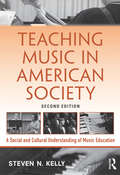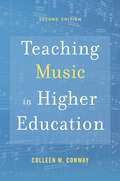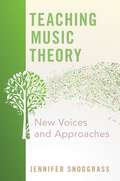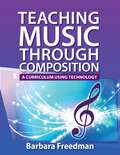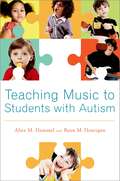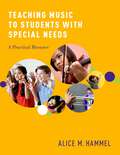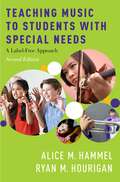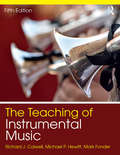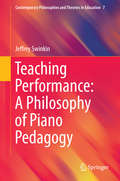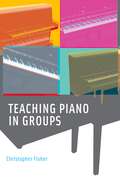- Table View
- List View
Teaching Music in American Society: A Social and Cultural Understanding of Music Education
by Steven N. KellySuccessful professional music teachers must not only be knowledgeable in conducting and performing, but also be socially and culturally aware of students, issues, and events that affect their classrooms. This book provides comprehensive overview of social and cultural themes directly related to music education, teacher training, and successful teacher characteristics. New topics in the second edition include the impact of Race to the Top, social justice, bullying, alternative schools, the influence of Common Core Standards, and the effects of teacher and school assessments. All topics and material are research-based to provide a foundation and current perspective on each issue.
Teaching Music in American Society: A Social and Cultural Understanding of Teaching Music
by Steven N. KellyTeaching Music in American Society, Third Edition, provides a comprehensive overview of social and cultural themes directly related to music education, teacher training, and successful teacher characteristics. Music teachers need to be not only knowledgeable in conducting and performing but also socially and culturally aware of students, issues, and events that affect their classrooms. This book is designed for educators seeking K-12 music teacher certification to teach in American schools. At the conclusion of each chapter is a summary of the chapter and a list of key items and people discussed, plus a series of related questions for students to consider. Current topics in the third edition include: • an emphasis on social justice, sensitivity to transgender students, and bullying, • the influences of social media, • a focus on urban music education, and • a new chapter on diverse learning. Further, recent policy issues are addressed in this new edition: • the evolution of the No Child Left Behind Act into the Every Student Succeeds Act, • the increasing emphasis on charter schools, the privatization of public school, • changes in how schools are assessed, and • changes occurring within the teaching profession—and how all of these affect developments in music education. A major structural change is the chapter on equality of education has been split into two chapters, providing a stronger focus on both educational equality and diverse inclusive learning.
Teaching Music in American Society: A Social and Cultural Understanding of Teaching Music
by Steven N. KellyTeaching Music in American Society, Third Edition, provides a comprehensive overview of social and cultural themes directly related to music education, teacher training, and successful teacher characteristics. Music teachers need to be not only knowledgeable in conducting and performing but also socially and culturally aware of students, issues, and events that affect their classrooms. This book is designed for educators seeking K-12 music teacher certification to teach in American schools. At the conclusion of each chapter is a summary of the chapter and a list of key items and people discussed, plus a series of related questions for students to consider. Current topics in the third edition include: • an emphasis on social justice, sensitivity to transgender students, and bullying, • the influences of social media, • a focus on urban music education, and • a new chapter on diverse learning. Further, recent policy issues are addressed in this new edition: • the evolution of the No Child Left Behind Act into the Every Student Succeeds Act, • the increasing emphasis on charter schools, the privatization of public school, • changes in how schools are assessed, and • changes occurring within the teaching profession—and how all of these affect developments in music education. A major structural change is the chapter on equality of education has been split into two chapters, providing a stronger focus on both educational equality and diverse inclusive learning.
Teaching Music in Higher Education
by Colleen M. ConwayWith five newly written chapters and sizable additions to nine original chapters, this second edition of Teaching Music in Higher Education provides a welcome update to author Colleen M. Conway's essential guide. In the book's new chapters, Conway offers insights beyond music and cognition including gender identity, sexual identity, and issues of cultural diversity not addressed in the first edition. Conway also covers technology in instructional settings and includes new references and updated student vignettes. Designed for faculty and graduate assistants working with undergraduate music majors as well as non-majors in colleges and universities, the book is designed to fit within a typical 15-week semester. The book's three sections address concerns about undergraduate curricula that meet National Association of School of Music requirements as well as teacher education requirements for music education majors in most states. Part I includes chapters on assessment and grading in music courses; understanding students' cognitive, musical, and identity growth; and syllabus design. Part II focuses on creating a culture for learning; instructional strategies to facilitate active learning; and applied studio teaching. Part III addresses growth in teaching practices for the college music professor and focuses on the job search in higher education, feedback from students, and navigating a career in higher education. The book features highly useful templates including a departmental assessment report, forms for student midterm and final evaluation, a Faculty Activities Report for music professors, and a tenure and promotion materials packet. Each of the three sections of the book makes reference to relevant research from the higher education or learning sciences literature as well as suggestions for further reading in the various topic areas.
TEACHING MUSIC IN HIGHER EDUCATION 2E C
by Colleen M. ConwayWith five newly written chapters and sizable additions to nine original chapters, this second edition of Teaching Music in Higher Education provides a welcome update to author Colleen M. Conway's essential guide. In the book's new chapters, Conway offers insights beyond music and cognition including gender identity, sexual identity, and issues of cultural diversity not addressed in the first edition. Conway also covers technology in instructional settings and includes new references and updated student vignettes. Designed for faculty and graduate assistants working with undergraduate music majors as well as non-majors in colleges and universities, the book is designed to fit within a typical 15-week semester. The book's three sections address concerns about undergraduate curricula that meet National Association of School of Music requirements as well as teacher education requirements for music education majors in most states. Part I includes chapters on assessment and grading in music courses; understanding students' cognitive, musical, and identity growth; and syllabus design. Part II focuses on creating a culture for learning; instructional strategies to facilitate active learning; and applied studio teaching. Part III addresses growth in teaching practices for the college music professor and focuses on the job search in higher education, feedback from students, and navigating a career in higher education. The book features highly useful templates including a departmental assessment report, forms for student midterm and final evaluation, a Faculty Activities Report for music professors, and a tenure and promotion materials packet. Each of the three sections of the book makes reference to relevant research from the higher education or learning sciences literature as well as suggestions for further reading in the various topic areas.
Teaching Music Musically (Classic Edition)
by Keith Swanwick'There are countless gems within these pages ... Swanwick seems to write from more experience as a musician and teacher than most others who write for this audience. There is a real sense of his having been there. - Patricia Shehan Campbell, Professor of Music, University of Washington, USA'... contains the essential and highly valued hallmark of
Teaching Music Musically (Classic Edition)
by Keith Swanwick'There are countless gems within these pages ... Swanwick seems to write from more experience as a musician and teacher than most others who write for this audience. There is a real sense of his having been there. - Patricia Shehan Campbell, Professor of Music, University of Washington, USA'... contains the essential and highly valued hallmark of
Teaching Music Theory: New Voices and Approaches
by Jennifer SnodgrassIn recent years, music theory educators around the country have developed new and innovative teaching approaches, reintroducing a sense of purpose into their classrooms. In this book, author and veteran music theory educator Jennifer Snodgrass visits several of these teachers, observing them in their music theory classrooms and providing lesson plans that build upon their approaches. Based on three years of field study spanning seventeen states, coupled with reflections on her own teaching strategies,ÂTeaching Music Theory: New Voices and Approaches highlights real-life teaching approaches from effective (and sometimes award-winning) instructors from a wide range of institutions: high schools, community colleges, liberal arts colleges, and conservatories. Throughout the book, Snodgrass focuses on topics like classroom environment, collaborative learning, undergraduate research and professional development, and curriculum reform. She also emphasizes the importance of a diverse, progressive, and inclusive teaching environment throughout, from encouraging student involvement in curriculum planning to designing lesson plans and assessments so that pedagogical concepts can easily be transferred to the applied studio, performance ensemble, and other courses outside of music. An accessible and valuable text designed with the needs of both students and faculty in mind,Teaching Music Theory provides teachers with a vital set of tools to rejuvenate the classroom and produce confident, empowered students.
TEACHING MUSIC THEORY C: New Voices and Approaches
by Jennifer SnodgrassIn recent years, music theory educators around the country have developed new and innovative teaching approaches, reintroducing a sense of purpose into their classrooms. In this book, author and veteran music theory educator Jennifer Snodgrass visits several of these teachers, observing them in their music theory classrooms and providing lesson plans that build upon their approaches. Based on three years of field study spanning seventeen states, coupled with reflections on her own teaching strategies,ÂTeaching Music Theory: New Voices and Approaches highlights real-life teaching approaches from effective (and sometimes award-winning) instructors from a wide range of institutions: high schools, community colleges, liberal arts colleges, and conservatories. Throughout the book, Snodgrass focuses on topics like classroom environment, collaborative learning, undergraduate research and professional development, and curriculum reform. She also emphasizes the importance of a diverse, progressive, and inclusive teaching environment throughout, from encouraging student involvement in curriculum planning to designing lesson plans and assessments so that pedagogical concepts can easily be transferred to the applied studio, performance ensemble, and other courses outside of music. An accessible and valuable text designed with the needs of both students and faculty in mind,Teaching Music Theory provides teachers with a vital set of tools to rejuvenate the classroom and produce confident, empowered students.
Teaching Music Through Composition: A Curriculum Using Technology
by Barbara FreedmanTeaching Music through Composition offers a practical, fully multimedia curriculum designed to teach basic musical concepts through the creative process of music composition. Author and award-winning music educator Barbara Freedman presents classroom-tested ways of teaching composition with technology as a tool with which students can create, edit, save, and reproduce music. As Freedman demonstrates, technology allows a musical experience for all skill levels in opportunities never before available to compose manipulate, instantly listen to music electronically and even print standard Western music notation for others to play without having to know much about traditional music theory or notation. All students can have meaningful hands-on applied learning experiences that will impact not only their music experience and learning but also their understanding and comfort with 21st century technology. Whether the primary focus of your class is to use technology to create music or to explore using technology in a unit or two, this book will show you how it can be done with practical, tried-and-true lesson plans and student activities.
Teaching Music Through Composition: A Curriculum Using Technology
by Barbara FreedmanTeaching Music through Composition offers a practical, fully multimedia curriculum designed to teach basic musical concepts through the creative process of music composition. Author and award-winning music educator Barbara Freedman presents classroom-tested ways of teaching composition with technology as a tool with which students can create, edit, save, and reproduce music. As Freedman demonstrates, technology allows a musical experience for all skill levels in opportunities never before available to compose manipulate, instantly listen to music electronically and even print standard Western music notation for others to play without having to know much about traditional music theory or notation. All students can have meaningful hands-on applied learning experiences that will impact not only their music experience and learning but also their understanding and comfort with 21st century technology. Whether the primary focus of your class is to use technology to create music or to explore using technology in a unit or two, this book will show you how it can be done with practical, tried-and-true lesson plans and student activities.
Teaching Music to Students with Autism
by Alice M. Hammel Ryan M. HouriganTeaching Music to Students with Autism is a comprehensive resource for everyone who works with students with autism within the music classroom. The authors focus on understanding autism, advocating for students and music programs, and creating and maintaining a team approach by working together with colleagues effectively. A significant portion of the book is focused on understanding and overcoming the communication, cognition, behavior, sensory, and socialization challenges inherent in working with students with autism. The authors suggest ways to structure classroom experiences and learning opportunities for all students. The book includes vignettes and classroom snapshots from experienced music teachers which provide additional opportunities to transfer theory to real-life application.
Teaching Music to Students with Autism
by Alice M. Hammel Ryan M. HouriganTeaching Music to Students with Autism is a comprehensive practical guide for music educators who work with students with autism. Authors and veteran music educators Alice M. Hammel and Ryan M. Hourigan offer an approach centered in inclusion designed for music educators, music teacher educators, and all those who have an interest in the education of students with autism. In this second edition, the authors offer fully up-to-date information on the diagnosis of autism, advocating for students and music programs, and creating and maintaining a team-approach when working with colleagues. A significant portion of the book is focused on understanding the communication, cognition, behavior, sensory, and socialization challenges inherent in students with autism and ways to structure classroom experiences and learning opportunities for all students. A chapter of classroom snapshots (vignettes) written by teachers in the field of music education provides additional opportunities to transfer information to 'real life' situations. Finally, the book offers a chapter of print and web resources for further study.
Teaching Music to Students with Autism
by Alice M. Hammel Ryan M. HouriganTeaching Music to Students with Autism is a comprehensive practical guide for music educators who work with students with autism. Authors and veteran music educators Alice M. Hammel and Ryan M. Hourigan offer an approach centered in inclusion designed for music educators, music teacher educators, and all those who have an interest in the education of students with autism. In this second edition, the authors offer fully up-to-date information on the diagnosis of autism, advocating for students and music programs, and creating and maintaining a team-approach when working with colleagues. A significant portion of the book is focused on understanding the communication, cognition, behavior, sensory, and socialization challenges inherent in students with autism and ways to structure classroom experiences and learning opportunities for all students. A chapter of classroom snapshots (vignettes) written by teachers in the field of music education provides additional opportunities to transfer information to 'real life' situations. Finally, the book offers a chapter of print and web resources for further study.
Teaching Music to Students with Autism
by Alice M. Hammel Ryan M. HouriganTeaching Music to Students with Autism is a comprehensive resource for everyone who works with students with autism within the music classroom. The authors focus on understanding autism, advocating for students and music programs, and creating and maintaining a team approach by working together with colleagues effectively. A significant portion of the book is focused on understanding and overcoming the communication, cognition, behavior, sensory, and socialization challenges inherent in working with students with autism. The authors suggest ways to structure classroom experiences and learning opportunities for all students. The book includes vignettes and classroom snapshots from experienced music teachers which provide additional opportunities to transfer theory to real-life application.
Teaching Music to Students with Differences and Disabilities: A Label-Free Approach
by Alice M. Hammel Ryan M. HouriganThe latest edition of the landmark text Teaching Music to Students with Differences and Disabilities: A Label-Free Approach--designed for music education faculty, in-service music administrators, in-service music teachers, and preservice music teachers--offers a comprehensive manual and reference guide that introduces those in the field of music education to best practices when teaching music to students with differences and disabilities. Acclaimed pedagogues and clinicians Alice Hammel and Ryan Hourigan addresses a variety of topics such as research-based strategies for methods courses, practical approaches for in-service music educators, and professional development grounded in research, special education law, and best practice. Like previous editions, a core focus this book is that a student with differences and disabilities is an individual who deserves a music education that is free of labels. This philosophical premise of a label-free approach is centered in the preservation of the individual personhood of each student. Through this approach, music educators will be able to gain and advocate for support, understand their rights and responsibilities, and offer an affective and effective music education for students with and without disabilities. This includes learning strategies for effective collaboration with special educators, teacher educators, and classroom teachers. The authors also include curriculum development ideas, lesson plan strategies, observation strategies (methods classroom), and practical ideas (methods classroom).
Teaching Music to Students with Differences and Disabilities: A Label-Free Approach
by Alice M. Hammel Ryan M. HouriganThe latest edition of the landmark text Teaching Music to Students with Differences and Disabilities: A Label-Free Approach--designed for music education faculty, in-service music administrators, in-service music teachers, and preservice music teachers--offers a comprehensive manual and reference guide that introduces those in the field of music education to best practices when teaching music to students with differences and disabilities. Acclaimed pedagogues and clinicians Alice Hammel and Ryan Hourigan addresses a variety of topics such as research-based strategies for methods courses, practical approaches for in-service music educators, and professional development grounded in research, special education law, and best practice. Like previous editions, a core focus this book is that a student with differences and disabilities is an individual who deserves a music education that is free of labels. This philosophical premise of a label-free approach is centered in the preservation of the individual personhood of each student. Through this approach, music educators will be able to gain and advocate for support, understand their rights and responsibilities, and offer an affective and effective music education for students with and without disabilities. This includes learning strategies for effective collaboration with special educators, teacher educators, and classroom teachers. The authors also include curriculum development ideas, lesson plan strategies, observation strategies (methods classroom), and practical ideas (methods classroom).
Teaching Music to Students with Special Needs: A Practical Resource
by Alice M. HammelTeaching Music to Students with Special Needs: A Practical Resource brings together theory, policy, and planning for instruction in K-12 classrooms. The resource is a result of collaboration between K-12 teachers, outstanding undergraduate and graduate music education students, and professionals in the field. The lesson ideas, lesson plans, and unit plans are organized according to the six domains posited by Alice Hammel and Ryan Hourigan in their book, Teaching Music to Students with Special Needs: A Label-free Approach, Second Edition. This book equips music educators with understanding necessary to implement teaching ideas into the domains of cognition, communication, behavior, emotions, and physical and sensory needs. Classroom-tested lesson plans include procedure outlines and assessments as well as guides for adaptation, accommodation, and modification needed for successful implementation in K-12 classrooms. As such, this eminently useful guide provides teachers with enough practical ideas to allow them to begin to create and adapt their own lesson plans for use with students of differing needs and abilities.
Teaching Music to Students with Special Needs: A Practical Resource
by Alice M. HammelTeaching Music to Students with Special Needs: A Practical Resource brings together theory, policy, and planning for instruction in K-12 classrooms. The resource is a result of collaboration between K-12 teachers, outstanding undergraduate and graduate music education students, and professionals in the field. The lesson ideas, lesson plans, and unit plans are organized according to the six domains posited by Alice Hammel and Ryan Hourigan in their book, Teaching Music to Students with Special Needs: A Label-free Approach, Second Edition. This book equips music educators with understanding necessary to implement teaching ideas into the domains of cognition, communication, behavior, emotions, and physical and sensory needs. Classroom-tested lesson plans include procedure outlines and assessments as well as guides for adaptation, accommodation, and modification needed for successful implementation in K-12 classrooms. As such, this eminently useful guide provides teachers with enough practical ideas to allow them to begin to create and adapt their own lesson plans for use with students of differing needs and abilities.
Teaching Music to Students with Special Needs: A Label-Free Approach
by Alice M. Hammel Ryan M. HouriganThe Second Edition of Teaching Music to Students with Special Needs offers updated accounts of music educators' experiences, featured as vignettes throughout the book. An accompanying Practical Resource includes lesson plans, worksheets, and games for classroom use. As a practical guide and reference manual, Teaching Music to Students with Special Needs, Second Edition addresses special needs in the broadest possible sense to equip teachers with proven, research-based curricular strategies that are grounded in both best practice and current special education law. Chapters address the full range of topics and issues music educators face, including parental involvement, student anxiety, field trips and performances, and assessment strategies. The book concludes with an updated list of resources, building upon the First Edition's recommendations.
The Teaching of Instrumental Music
by Richard Colwell Michael Hewitt Mark FonderThe Teaching of Instrumental Music, Fifth Edition introduces music education majors to basic instrumental pedagogy for the instruments and ensembles commonly found in the elementary and secondary curricula. It focuses on the core competencies required for teacher certification in instrumental music, with the pervasive philosophy to assist teachers as they develop an instrumental music program based on understanding and respecting all types of music. Parts I and II focus on essential issues for a successful instrumental program, presenting first the history and foundations, followed by effective strategies in administrative tasks and classroom teaching. Parts III, IV, and V are devoted to the skills and techniques of woodwind, brass and percussion, and string instruments. In all, The Teaching of Instrumental Music is the complete reference for the beginning instrumental teacher, commonly retained in a student’s professional library for its unique and comprehensive coverage. NEW TO THIS EDITION: Revision and updating of curriculum developments, such as coordinating State Department of Education student learning objectives with the recent Every Student Succeeds Act (ESSA) New discussion of the NAfME National Standards as they relate to the teaching of instrumental music Revamping of rehearsing instrumental ensembles chapters, including new or expanded sections on programming, choosing quality music, and applying successful rehearsal techniques Updates on references, plus new discussion questions, and websites and internet links A chapter devoted to classroom guitar Updates on the use of technology for teaching and learning music More on healthy performance practice, marching band, and jazz band Online materials located in the eResources section on the Routledge website.
The Teaching of Instrumental Music
by Richard Colwell Michael Hewitt Mark FonderThe Teaching of Instrumental Music, Fifth Edition introduces music education majors to basic instrumental pedagogy for the instruments and ensembles commonly found in the elementary and secondary curricula. It focuses on the core competencies required for teacher certification in instrumental music, with the pervasive philosophy to assist teachers as they develop an instrumental music program based on understanding and respecting all types of music. Parts I and II focus on essential issues for a successful instrumental program, presenting first the history and foundations, followed by effective strategies in administrative tasks and classroom teaching. Parts III, IV, and V are devoted to the skills and techniques of woodwind, brass and percussion, and string instruments. In all, The Teaching of Instrumental Music is the complete reference for the beginning instrumental teacher, commonly retained in a student’s professional library for its unique and comprehensive coverage. NEW TO THIS EDITION: Revision and updating of curriculum developments, such as coordinating State Department of Education student learning objectives with the recent Every Student Succeeds Act (ESSA) New discussion of the NAfME National Standards as they relate to the teaching of instrumental music Revamping of rehearsing instrumental ensembles chapters, including new or expanded sections on programming, choosing quality music, and applying successful rehearsal techniques Updates on references, plus new discussion questions, and websites and internet links A chapter devoted to classroom guitar Updates on the use of technology for teaching and learning music More on healthy performance practice, marching band, and jazz band Online materials located in the eResources section on the Routledge website.
Teaching Performance: A Philosophy of Piano Pedagogy (Contemporary Philosophies and Theories in Education #7)
by Jeffrey SwinkinHow can the studio teacher teach a lesson so as to instill refined artistic sensibilities, ones often thought to elude language? How can the applied lesson be a form of aesthetic education? How can teaching performance be an artistic endeavor in its own right? These are some of the questions Teaching Performance attempts to answer, drawing on the author's several decades of experience as a studio teacher and music scholar. The architects of absolute music (Hanslick, Schopenhauer, and others) held that it is precisely because instrumental music lacks language and thus any overt connection to the non-musical world that it is able to expose essential elements of that world. More particularly, for these philosophers, it is the density of musical structure—the intricate interplay among purely musical elements—that allows music to capture the essences behind appearances. By analogy, the author contends that the more structurally intricate and aesthetically nuanced a pedagogical system is, the greater its ability to illuminate music and facilitate musical skills. The author terms this phenomenon relational autonomy. Eight chapters unfold a piano-pedagogical system pivoting on the principle of relational autonomy. In grounding piano pedagogy in the aesthetics of absolute music, each domain works on the other. On the one hand, Romantic aesthetics affords pedagogy a source of artistic value in its own right. On the other hand, pedagogy concretizes Romantic aesthetics, deflating its transcendental pretentions and showing the dichotomy of absolute/utilitarian to be specious.
Teaching Piano in Groups
by Christopher FisherTeaching Piano in Groups provides a one-stop compendium of information related to all aspects of group piano teaching. Motivated by an ever-growing interest in this instructional method and its widespread mandatory inclusion in piano pedagogy curricula, Christopher Fisher highlights the proven viability and success of group piano teaching, and arms front-line group piano instructors with the necessary tools for practical implementation of a system of instruction in their own teaching. Contained within are: a comprehensive history of group piano teaching; accessible overviews of the most important theories and philosophies of group psychology and instruction; suggested group piano curricular competencies; practical implementation strategies; and thorough recommendations for curricular materials, instructional technologies, and equipment. Teaching Piano in Groups also addresses specific considerations for pre-college teaching scenarios, the public school group piano classroom, and college-level group piano programs for both music major and non-music majors. Teaching Piano in Groups is accompanied by an extensive companion website, featuring a multi-format listing of resources as well as interviews with several group piano pedagogues.
Teaching Piano in Groups
by Christopher FisherTeaching Piano in Groups provides a one-stop compendium of information related to all aspects of group piano teaching. Motivated by an ever-growing interest in this instructional method and its widespread mandatory inclusion in piano pedagogy curricula, Christopher Fisher highlights the proven viability and success of group piano teaching, and arms front-line group piano instructors with the necessary tools for practical implementation of a system of instruction in their own teaching. Contained within are: a comprehensive history of group piano teaching; accessible overviews of the most important theories and philosophies of group psychology and instruction; suggested group piano curricular competencies; practical implementation strategies; and thorough recommendations for curricular materials, instructional technologies, and equipment. Teaching Piano in Groups also addresses specific considerations for pre-college teaching scenarios, the public school group piano classroom, and college-level group piano programs for both music major and non-music majors. Teaching Piano in Groups is accompanied by an extensive companion website, featuring a multi-format listing of resources as well as interviews with several group piano pedagogues.
